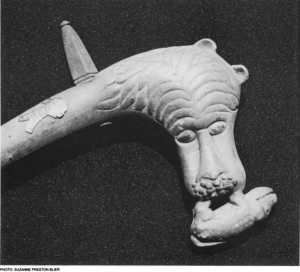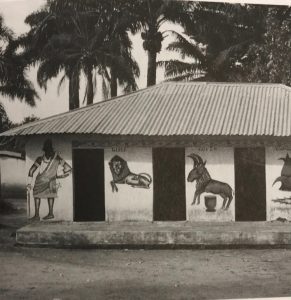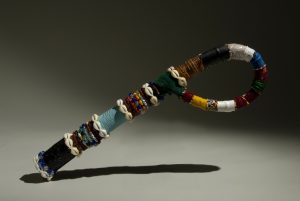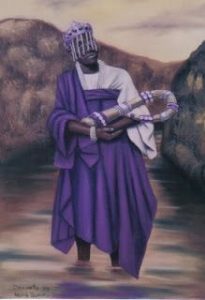One of the most striking pieces displayed at the Spirited Things: Sacred Arts of the Black Atlantic exhibit is the statue of Esu found at the front of the exhibition. A picture of the object is found at the bottom of this essay. The sculpture is carved from wood, measures twenty-two inches tall, and rests on a circular base with a diameter of about ten inches. Esu, known to many as the messenger orisha, is depicted on horseback, surrounded by ritual assistants. The figures surrounding Esu are far less intricate than the orisha himself, who is flush with detail and variety.
The purpose of this essay is to examine the details of this representation of Esu, provide analysis of the individual components of the statue, compare this Esu to other representations of the orisha, and to examine how Esu corresponds with the African Diaspora. The significance of Esu’s position, possessions, and ritual assistants will be examined. Another focus of this essay will be the physical depiction of Esu and its deeper meanings.
Esu is one of the most important of the Yoruba orishas. He is not, as previously thought, only associated with decisions and not a part of daily human life. On the contrary, “Almost every traditional household, clan or village, every devotee (irrespective of the cult to which he or she belongs) has the symbol and worship of Esu,” (Awolalu 29).
It is through Esu that people can contact and request assistance from the other orishas. Esu carries messages between the orishas and humans. However, Esu is often referred to as a malevolent trickster. Esu sometimes carries messages to their destination, but sometimes willfully forgets them or takes them to the wrong destination. When this occurs, havoc is wreaked in the mortal world. Esu is not a fool or an easily duped trickster, but a powerful orisha who commands respect and has harsh consequences for those who fail to show it (Ogundipe 193). Esu must be appeased or he is more likely to be unreliable in his messenger duties.
At this point, it is important to stress that Esu is not an evil, malevolent, or harmful orisha in Yoruba religion. Esu has often been misinterpreted as the devil by outsiders, or being a purely evil being. “He tempts people, but that does not mean that he is against the human race or will do only harm,” (Awolalu 28). According to Awolalu, it is easier to imagine Esu as a powerful deity that can help or harm. When treated with respect and reverence, Esu often assists mortals in their tasks, but, if offended, Esu can cause volumes of trouble in the mortal world.
However, in Brazilian Candomble, Esu has a slightly darker role. While portrayal of Esu as the devil by missionaries was strongly rejected in Yorubaland, the narrative was more in line in Brazil, keeping in tradition with syncretizing orisha with Catholic figures (Ogundipe 213). While not wholeheartedly evil, followers of Candomble accepted that Esu runs both malevolent and benevolent errands, and therefore has a dark side. Another intriguing Brazilian twist on Yoruba belief is that Esu is sometimes referred to as a slave, as he runs errands for mortals for little compensation (Ogundipe 214). While powerful, the reverence and respect for Esu does not appear to be as high in Candomble as compared to Yoruba.
Esu is also the lord of the crossroads, beginnings, and endings. When a person faces a crossroads or difficult decision, Esu is present and guides travelers. However, he may lead them down the wrong path. The duality found in Esu’s nature (he can either help or harm) is reflected in physical depictions of Esu. Esu is often depicted with a protrusion from the rear of his head, ranging from a small protrusion to more phallic depictions (Ogundipe 157). In this sculpture, the artist chose to create a serpent emerging from the rear of Esu’s skull. The serpent has its own face, and is devouring a helpless animal. This brutal depiction contrasts to a benevolent humanoid Esu portrayed on the other side. The contrast between the two sides of Esu’s head signifies that Esu can be helpful and resourceful, or can be cruel and damning. The power and might Esu has is exaggerated within this depiction.
The details of this Esu shed significant insight into what the creator believed about the orisha. Esu is mounted on a horse, and, although now missing, probably carried a flywhisk in his right hand. Both the horse and the flywhisk signify royalty and military prowess. That Esu is depicted in this manner is indicative that he was highly revered among followers of Yoruba. The attendants following Esu are depictions of devout followers, who in real life would be special priests and priestesses dedicated to Esu. These attendants carry various medicinal herbs and other ritual items. Esu’s mounted position and close-at-hand devotees symbolize his power, might, and royalty. In many depictions, Esu is portrayed with long hair, uncommon among Yoruba people except for the powerful and royalty (Ogundipe 171). In most portrayals of Esu, it is clear that he is highly respected and revered.
One of the most interesting aspects of this depiction of Esu is the humanoid face. This wooden Esu has facial scars why typify a specific people foreign to Yorubaland. Esu is also depicted with a beard typical of the Hausa People. The Hausa are a Muslim ethnic group native to northern Africa. However, to the Yoruba, the Hausa are a foreign population. Why would a Yoruba depiction of Esu cast him as a foreigner instead of a native? The conventional dialogue would have Esu depicted as a native and the Yoruba a descendant.
In my research I discovered that it is common for not just Esu but all orisha to be depicted a hailing from a foreign land. The Yoruba had great respect for their foreign neighbors. Depicting their gods with characteristics typical of their neighbors is a clear-cut example for the love and respect the Yoruba showed to foreigners. This depiction of Esu is therefore helpful in establishing that the Yoruba were kind to neighbors. Upon further examination, this claim is reinforced by evidence showing Yoruba respect for trans-local persons (Awolalu 186).
Unlike many other religions, Yoruba and most diasporic religions are very welcoming of foreign persons and concepts. Diasporic religions often incorporate symbols, signs, and powers from other religions such as Christianity into their practice. In some cases, this was just an easy way to refresh old concepts. In others, followers were able to worship their religion inconspicuously where it was not tolerated. Examples of rephrasing Yoruba doctrine into Christian terms include Santeria using Our Lady of Charity and Cobre as a representation of the orisha Oshun. This flexibility and hybridity were essential to the life and proliferation of many diasporic religions as native Africans expanded across the globe.
This statue of Esu would be used to adorn an indoor shrine. It would be at sacred processions for a specific orisha. It would carry messages from worshippers to the orisha which they hope to communicate with, and would send messages from the spirit world to the mortal one. This statue would appeal for an orisha’s benevolent intervention in the mortal world. Its important duties make this sculpture an essential part of an altar.
The two-foot wooden sculpture of Esu found in the Spirited Things exhibit is rife with intricate detail and symbolic meaning. Every part of Esu’s depiction has deeper meaning than face value. Esu’s prominent position, his follower’s worships, his facial depiction, and his serpent protrusion all have significant meaning and help to establish what the Yoruba people thought and believed in relating to Esu.
Bibliography:
Falola, Toyin. Èṣù : Yoruba God, Power, and the Imaginative Frontiers / Edited by Toyin Falola. Carolina Academic Press African World Series. 2013. pp.18-20
Ogundipe, Ayodele. Esu Elegbara, the Yoruba God of Chance and Uncertainty : A Study in Yoruba Mythology / by Ayodele Ogundipe. 1978, 1978. pp.151-220.
Awolalu, Omosade. Yoruba Beliefs and Sacrificial Rites. 1979, 1979. pp. 28-186
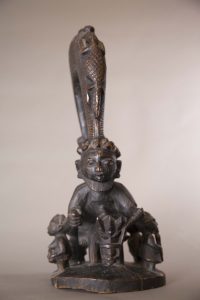

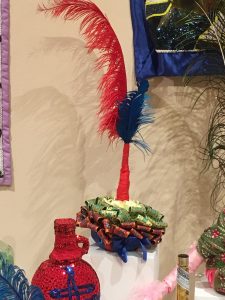
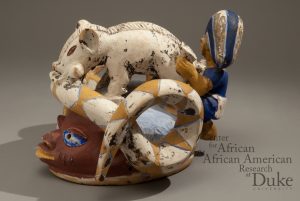
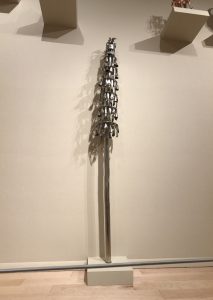
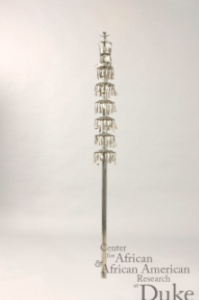
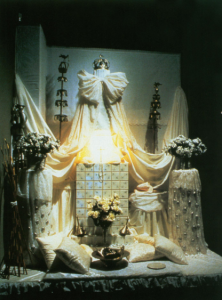
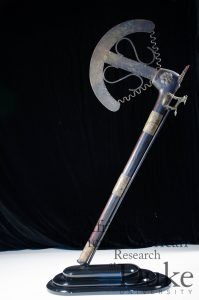 The object was stuck in a falling state, suspended in mid air. A weapon among an altar, a scepter with crowns surrounding. I wanted to know where there was such a violent looking object in a place where everything else is full of color and life. The scepter does not stand out. It has little color and small designs that are worn away. The handle is simple, wooden staff. The kind of wood that if you held it, it would give you splinters. There are three brass segments on staff and right above the one at the top there is a cat like creature. It is a very interesting creature with a big cat body and long ears or horns. One of the biggest reasons why I picked this object is this animal and the shadow it casts. The shadow from the display makes it look like the cat is walking along the staff. Right before the axe head, two horns protrude, similar to the cat’s ears . There is the blade that is made of metal with tidal waves throughout the edge. Two metal pieces hold down the blade, an S shape metal piece and a spring piece. The last thing on the scepter is a flower a 6 petal flower below the horns and next to the head. On every other petal there are bumps that seem to make a simple pattern. This lead me to what I wanted to learn from this object. Why is this deadly object in a place of worship. Even within the scepter there are juxtapositions as there is a flower that draws your eye to it. I wanted to learn everything about this scepter and the god it represented, Hevioso or shungo. Contrary to its looks, it is not a weapon, it a tool used for religious and political festivals. I question the meaning behind with the aspects of the king and the deity he represented. As a hot god, Hevioso in vodou or Shungo in yoruba tradition, he does things quickly and people who have him as a deity are usually in power. This leads me to argue that this scepter was used to show power over the king’s followers. In the rest of the paper, I will give background on Hevioso and how a different king follows him and basic information on vodou and Yoruba tradition. Next I will talk about a king who was represented by the same god, Hevioso, King Glele and will then show how the scepter would be used in a festival based on first hand basis of people who research the religion. I will explain the cat creature on top of the staff and the significance it has towards the scepter.
The object was stuck in a falling state, suspended in mid air. A weapon among an altar, a scepter with crowns surrounding. I wanted to know where there was such a violent looking object in a place where everything else is full of color and life. The scepter does not stand out. It has little color and small designs that are worn away. The handle is simple, wooden staff. The kind of wood that if you held it, it would give you splinters. There are three brass segments on staff and right above the one at the top there is a cat like creature. It is a very interesting creature with a big cat body and long ears or horns. One of the biggest reasons why I picked this object is this animal and the shadow it casts. The shadow from the display makes it look like the cat is walking along the staff. Right before the axe head, two horns protrude, similar to the cat’s ears . There is the blade that is made of metal with tidal waves throughout the edge. Two metal pieces hold down the blade, an S shape metal piece and a spring piece. The last thing on the scepter is a flower a 6 petal flower below the horns and next to the head. On every other petal there are bumps that seem to make a simple pattern. This lead me to what I wanted to learn from this object. Why is this deadly object in a place of worship. Even within the scepter there are juxtapositions as there is a flower that draws your eye to it. I wanted to learn everything about this scepter and the god it represented, Hevioso or shungo. Contrary to its looks, it is not a weapon, it a tool used for religious and political festivals. I question the meaning behind with the aspects of the king and the deity he represented. As a hot god, Hevioso in vodou or Shungo in yoruba tradition, he does things quickly and people who have him as a deity are usually in power. This leads me to argue that this scepter was used to show power over the king’s followers. In the rest of the paper, I will give background on Hevioso and how a different king follows him and basic information on vodou and Yoruba tradition. Next I will talk about a king who was represented by the same god, Hevioso, King Glele and will then show how the scepter would be used in a festival based on first hand basis of people who research the religion. I will explain the cat creature on top of the staff and the significance it has towards the scepter. 